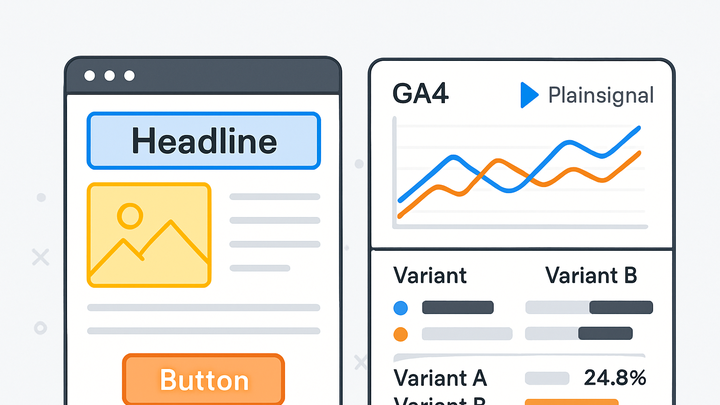Published on 2025-06-22T03:56:59Z
What is Multivariate Testing in Analytics? Examples & Best Practices
In analytics, multivariate testing is a method of experimentation that tests multiple variations of several page elements simultaneously to determine which combination performs best. Unlike A/B testing, which typically compares just two versions of a single element, multivariate testing explores the interactions between different elements—such as headlines, images, call-to-action buttons, and page layouts—to optimize overall performance. It uses a factorial design to systematically generate every possible combination of chosen variants and then distributes user traffic evenly to collect data on each combination’s effectiveness. Statistical analysis, including t-tests or Bayesian methods, identifies the most impactful elements and combinations. Modern analytics platforms like Google Analytics 4 (GA4) and PlainSignal (a cookie-free analytics solution) often support multivariate testing workflows, enabling marketers and product teams to make data-driven design decisions. By running these tests correctly, organizations can uncover deeper insights into user behavior, accelerate optimization cycles, and ultimately boost conversion rates. However, it requires sufficient traffic, careful planning, and attention to statistical rigor to yield reliable results.
Multivariate testing
Testing combinations of page elements simultaneously to discover the most effective layout for better engagement and conversions.
Why Multivariate Testing Matters
Multivariate testing provides a deeper level of insight compared to single-variable tests. It uncovers how different elements interact and which combinations drive the most significant improvements in user engagement and conversions.
-
Optimizing complex pages
Allows simultaneous testing of several elements like headlines, images, and CTAs, making it ideal for pages with multiple conversion drivers.
-
Faster insights
By testing multiple elements at once, teams can gather insights on all variables in a single experiment rather than sequential A/B tests.
-
Data-driven decisions
Identifies the strongest combinations through statistical analysis, enabling teams to make evidence-based design and content changes.
How Multivariate Testing Works
Multivariate testing relies on experimental design and statistical methods to evaluate multiple variable combinations. It ensures each variant receives enough traffic to produce statistically significant results.
-
Factorial design
Creates all possible combinations of chosen variants either as a full factorial (every combination) or fractional factorial (a subset) to balance test scope and traffic requirements.
-
Traffic allocation
Equally distributes incoming users across all variant combinations, ensuring each permutation is tested fairly.
-
Statistical analysis
Applies t-tests, Bayesian inference, or other statistical models to detect which combinations perform significantly better than a baseline.
Implementing with GA4 and PlainSignal
Guidance on how to set up, run, and measure multivariate tests using Google Analytics 4 and PlainSignal.
-
Setting up in GA4
Use GA4’s Experiments feature to configure a multivariate test, define variants, set objectives, and target specific audiences.
-
Create experiment
Navigate to Configure > Experiments in GA4 to create a new test and add your variant details.
-
Define objectives
Select conversion events or engagement metrics in GA4 to measure the success of each variant combination.
-
-
Setting up in PlainSignal
Integrate PlainSignal’s cookie-free analytics and leverage its API to manage variants directly in your site’s code.
-
Include tracking code
Add PlainSignal’s script snippet to your HTML before the closing </head> tag.
-
Define variants
Use PlainSignal’s JavaScript API to programmatically modify page elements and track variant performance.
-
-
Example tracking code
Example of integrating PlainSignal for multivariate testing.
-
Html snippet
<link rel="preconnect" href="//eu.plainsignal.com/" crossorigin /><script defer data-do="yourwebsitedomain.com" data-id="0GQV1xmtzQQ" data-api="//eu.plainsignal.com" src="//cdn.plainsignal.com/plainsignal-min.js"></script>
-
Best Practices and Considerations
Tips to run efficient, reliable, and ethical multivariate tests that yield actionable insights.
-
Limit variables
Test no more than 3–4 elements at once to prevent too many combinations and long test durations.
-
Ensure sufficient traffic
Only run multivariate tests on high-traffic pages so each variant receives enough visits for statistical significance.
-
Monitor experiment duration
Keep tests running for at least one full business cycle or until predetermined significance levels are reached.
